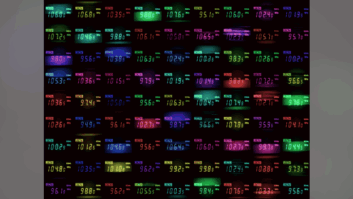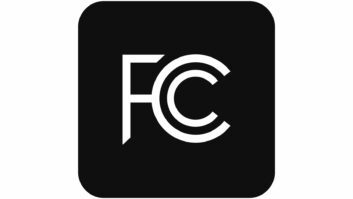Among the many victims of Hurricane Irma in September was the transmitter/antenna farm of Radio Miami International, WRMI in Okeechobee, located on a cattle ranch 40 miles inland from Port St. Lucie on Florida’s Atlantic coast.

Folded tower.
On Sunday Sept. 10, Irma’s roaring winds tore across the flat plains housing WRMI’s 23 antenna systems, comprising a total of 68 towers — the largest commercial shortwave radio transmission site in the United States. The hurricane-force winds snapped one of WRMI’s towers in half, leaving the torn metal lattice dangling suspended in the transmission lines. A second tower was bent in half like a paperclip. Many transmission lines radiating from WRMI’s central 16,000-square-foot transmitter building to the arrays also were knocked down along with the telephone poles that supported them.
The post-Irma scene looked as if a drunken giant had wandered across the cattle ranch and tripped repeatedly, taking down whatever he had stumbled across.
Add a main power outage that lasted from Sunday to Wednesday, and WRMI was definitely hammered by Hurricane Irma. Yet the station managed to stay on air throughout the chaos, thanks to the efforts of WRMI Facility Manager Pat Travers and five others who hunkered down in the reinforced concrete transmitter building during the storm.
“We have a 25 kilowatt diesel generator on site, which powered a 100-watt shortwave transmitter feeding a dipole antenna,” WRMI General Manager Jeff White said. “This kept WRMI’s programming on air to the world 24/7 throughout Irma.”

Granted, 100 watts has nothing on 100,000 watts, the power rating common to most of WRMI’s 14 SW transmitters. To cover the world successfully by bouncing radio signals off the ionosphere, serious transmitter power is required.
“But as any amateur radio operator will tell you, you can cover a lot of ground with 100 watts,” White quipped. “We received reception reports from listeners as far away as southern Ontario and Sacramento, Calif., who had picked up our 100 watts Irma transmissions.”
MEGA TRANSMISSION SITE
Built originally by Christian broadcaster WYFR (Family Radio) to reach the world, the Okeechobee transmitter/farm was purchased by WRMI in 2013.
Previously, the commercial shortwave station founded by White and his partner Kiko Espinosa (chief engineer, deceased in 2005) had broadcast from Miami via a 50,000-watt SW transmitter using either a corner reflector antenna beaming 160 degrees toward the Caribbean and Latin America, or a yagi-style log periodic antenna beaming 317 degrees toward North America. The two original antennas were used at different times of the day, depending on which part of the hemisphere was being served.
With the acquisition of the Okeechobee antenna farm in 2013, WRMI’s transmission options became global; the station subsequently shut down its Miami transmitter site while retaining its studio and office in that city.
Click to Enlarge

STORM PATROL
Spreading out from the transmitter building in a hub-and-spoke pattern of antenna arrays, antenna switchers and feeder lines, the station’s transmission infrastructure is an RF engineer’s fantasy of curtain array, log periodic and double rhombic antennas collectively aimed at 11 regions of the globe. Add 14 high-power SW transmitters, and WRMI has a near-perfect platform for transmitting its own English and Spanish programming worldwide and for leasing airtime to third-party broadcasters.
The threat of hurricanes is nothing new to Jeff White.
“I have operated stations through a few of them,” he said. “So I know what it takes to prepare for a hurricane, and to keep things going when it hits and during the recovery process afterwards.”
Fortunately WRMI’s transmitter building is strong enough to survive a hurricane. The original roof had been damaged by a previous storm when Family Radio owned this site. But they replaced it with a super-strong roof that could resist high winds and did just that during Irma’s onslaught.
Meanwhile, White always has lots of diesel fuel on hand to keep the station’s 25 kW generator running, “many five-gallon water jugs for us and our water-cooled transmitters,” and plenty of gasoline for the station’s trucks. “We have an old Florida Power truck with a cherry-picker for putting up telephone poles and attaching wires to them,” he said. “You need to have your own to maintain a site of this size.”
With plenty of food supplies and bedding, the WRMI crew hunkered down at the antenna farm.
“At 4:30 on Sunday afternoon, the winds starting whipping up,” White said. “Next the alarm bells started ringing, which tell us when transmission paths have been interrupted due to fallen lines. Then we lost electricity from outside, knocking our main transmitters offline. So we powered up the generator to keep the lights on, turned on the 100-watt backup transmitter and stayed on air via the dipole antenna as best we could.”

The facility’s transmission line grid suffered damage in several places.
FALLOUT AND RECOVERY
The two towers wrecked by Irma are part of WRMI’s 44 degree double rhombic array aimed at Europe and the Middle East. Before the storm, the station transmitted on 15770 kHz on this array. It delivered a strong, reliable signal to this market on this channel.
“With the loss of the 44 degree array, we have switched to other arrays to cover Europe and the Middle East on 7780 kHz and 11580 kHz,” said White. “I don’t know when we will be able to afford to replace the two towers Irma damaged, so this will have to do for now.”
The fallen transmission lines and poles were not a big issue. “Right after the storm, our crew got out in our used Florida Power truck and started putting things right,” White said 12 days afterwards. “Today, almost everything is back in place — and 13 of our 14 transmitters are already back on air.”
WRMI’s antenna farm had external power restored on Sept. 13. “Our internet was down for a while after that,” said White. “This left us trying to link up to the outside world using a microwave internet link, which was problematic.”
Still, not long after Hurricane Irma did its worst to WRMI’s Okeechobee antenna farm, this commercial SW broadcaster was back in business.
“We have yet to figure out how to repair the 44-degree double rhombic array and its two destroyed towers,” said White. “But other than that, Radio Miami International has bounced back from Irma quite quickly.”







